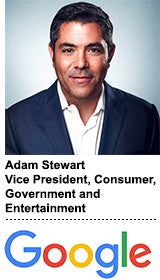Contrary to popular belief, video did not kill the radio star. It made them a YouTube influencer.
Advertisers use influencer marketing to reach consumers at a time of increased ad aversion. But the sheer volume of influencers and content on YouTube alone can be overwhelming for advertisers searching for the best fit for their brand.
This is part of the challenge that Adam Stewart, Google’s VP of consumer goods, government and entertainment, tackles every day.
“We focus on [advertisers’] business objectives,” Stewart told AdExchanger during Advertising Week in New York City. “If you’re Netflix, you need to gain more subscribers. If you’re Sony Pictures, you want to get people to the box office. If you’re Ford, you want to get people to drive a car.”
Stewart and his team help facilitate the connections between brands and YouTube influencers. This symbiotic relationship between marketer and influencer is one of the reasons Google invests heavily in the FameBit by YouTube marketing platform. The software helps connect brands with the best influencer for their products. Hollister, NBC and Keurig have used the platform to collaborate with YouTube creators on campaigns.
AdExchanger spoke with Stewart to discuss the YouTube influencer phenomenon.
AdExchanger: How has influencer marketing on YouTube evolved?
ADAM STEWART: Influencer marketing has been around for a very long time. If you go back to the early days of television, you had a host who was holding up a product and things like that. I do think the difference between then and now is if you think about YouTube creators and the relationship they have with their audiences, authenticity is at the core.
So consumers, especially fans of creators, can sniff out something that doesn’t necessarily belong. If you look at where influencer marketing has gone, I think that accountability a creator has to their audience now plays a role in how they think about introducing products.
Is influencer marketing more transparent nowadays?
Transparency is absolutely at the core. And I think if you were to think about [influencer marketing] on TV a long time ago, it’s fair to say things were more forced.
But influencer marketing [today] is a real benefit to creators. They’re out there making great content, it’s ad-supported, but the fact that [influencer] marketing is out there and available to them to continue to build their businesses is crucial.
What challenges does influencer marketing pose to brands?
It’s hard as a marketer. There are so many influencers out there. If you’re in a certain vertical it’s easy to know, “Hey, here are the folks who do auto really well,” or “These are the folks that do food really well.” But even with all that, you still have to consider how many creators come up into the community. YouTube has grown so much over time that there are people that have been popular from the beginning, but there are also new people on the platform right now that continue to grow audiences.
How is Google tackling that?
One of the things we’ve invested in is FameBit. One of the main challenges marketers face is how to connect with the right creator or figuring out who’s going to be the person to provide the right type of influence for their brand. FameBit is essentially a platform that allows brands to connect with influencers at scale and understand who’s right for them.
How does YouTube leverage its data? What types of data are available?
With FameBit, brands can get a package of services that includes content creation, distribution from the YouTubers’ engaged subscriber base, media amplification and SEO positioning of content. Prior to FameBit, there was no scalable way to do branded content. Brands would have to find and contact creators directly or go through different partners to figure out the creative, ambassadors and distribution.
FameBit brings the right creators to brands. From the moment that a campaign is deployed, interested influencers send proposals with their creative ideas. Brands can filter proposals by relevant criteria to select the best creators for them.
We [use] audience insights to help brands make the right hiring decisions, such as audience demographics and psychographics, average views, watch time, view-to-sub ratio, historical conversion data and unduplicated unique reach.
How do you enable measurement and accountability of influencer buys?
Some recent measurement launches include Search Lift, which we launched in Q1 for all FameBit campaigns. Search Lift gives brands the ability to see the uplift in Google and YouTube searches after creators mention brands in their videos. So far, for 90% of campaigns, we are seeing an average 21x lift in search in the four hours post exposure.
We also launched Influence Lift in Q3. FameBit Influence Lift allows brands to understand how their FameBit campaigns are driving upper- and lower-funnel brand metrics in real time based on user survey responses. This is the first time we’ve ever offered any brand lift measurement solutions on organic video content, and it will allow brands to optimize their influence across creators and campaigns.
Also starting Q3, FameBit will offer the ability to measure online conversion post-exposure to a FameBit video. This means that brands will be able to see what happens post-view.
What’s the next step for influencer marketing?
I think the trend is alive and well. I think it’ll continue to grow. I spend a lot of my time thinking about brands and the importance of building brands. Building brands today is harder than it’s ever been because of technology, fragmentation and ad aversion. All these factors play into the challenges advertisers face every single day. So I think we’ll continue to see influencer marketing grow because it is a way to provide a more authentic connection.














